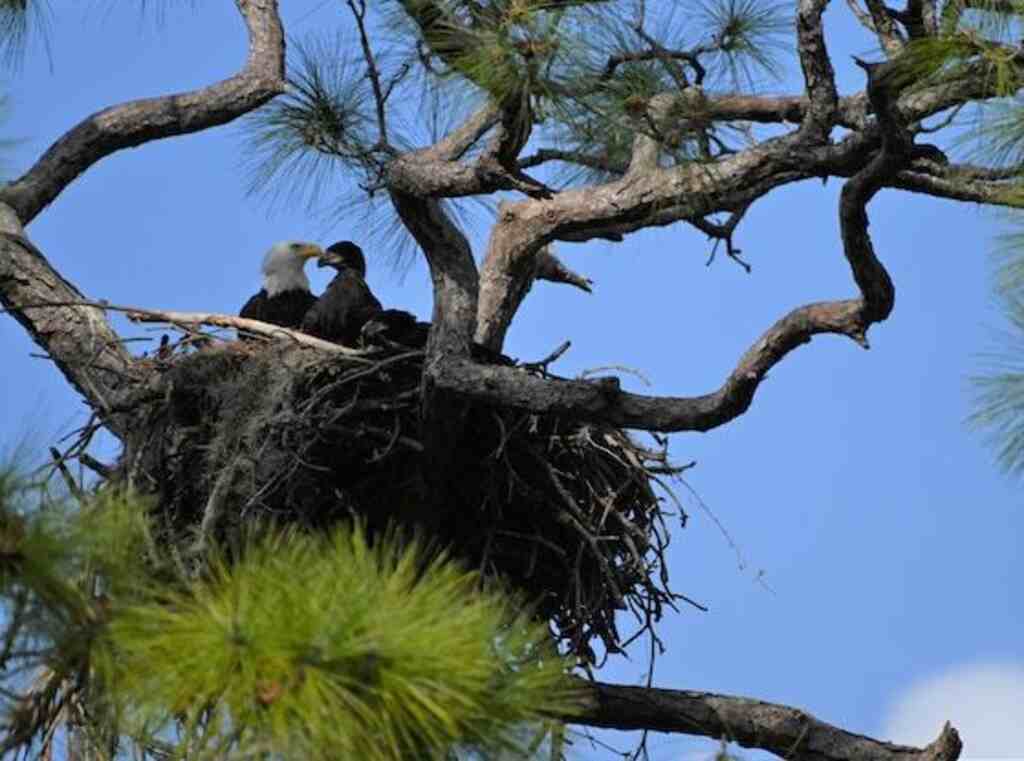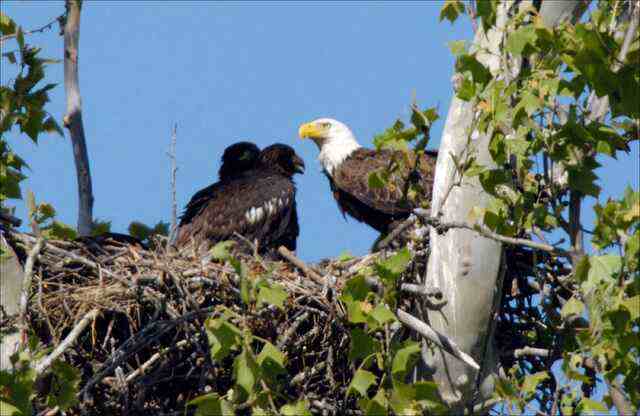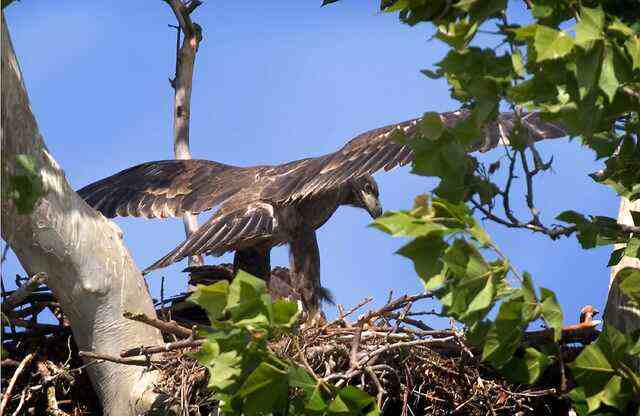When do eagles lay eggs? Ah, the eternal question that has intrigued both bird enthusiasts and aspiring avian matchmakers alike.
Well, my feathered friends, the answer is not as simple as “on sunny Sundays” or “when the moon is in the seventh house.”
Fear not, for within this delightful article lies the key to understanding the mysterious timing of eagle egg-laying. So, grab your binoculars and let’s embark on this eggcellent adventure!
Table of Contents
- 1 Overview of Eagles as Majestic Birds of Prey
- 2 Importance of Understanding the Egg-Laying Process
- 3 Background on Eagle Reproduction
- 4 When Do Eagles Lay Eggs
- 5 The Egg-Laying Season
- 6 Factors Influencing Egg-Laying Timing
- 7 Nest Preparation and Egg Formation Process
- 8 Insight into Female Eagles’ Physiological Changes
- 9 Conclusion
- 10 Author
Overview of Eagles as Majestic Birds of Prey
Eagles belong to the family Accipitridae and are characterized by their large size, hooked beaks, sharp talons, and piercing gaze.
They are found on every continent except Antarctica and are known by various names such as bald eagles (Haliaeetus leucocephalus) in North America and martial eagles (Polemaetus bellicosus) in Africa.
With wingspans that can exceed six feet and impressive aerial abilities, eagles have rightfully earned their place as kings of the avian world.
These birds possess an extraordinary combination of strength and elegance that allows them to soar high above open landscapes or dive swiftly towards prey.
Their exceptional eyesight enables them to spot small mammals or fish from great distances with remarkable precision.
Eagles’ strong talons allow them to capture and carry off prey with ease – a testament to their formidable hunting skills.

Importance of Understanding the Egg-Laying Process
While observing an eagle soaring across the sky is undoubtedly enthralling, delving into the intricacies of their reproductive cycle offers invaluable insights into these magnificent creatures’ lives.
The process by which eagles lay eggs plays a crucial role not only in sustaining eagle populations, but also in understanding broader ecological dynamics.
Studying the egg-laying process helps scientists and conservationists monitor the health of eagle populations, assess reproductive success, and identify potential threats or challenges eagles face.
This knowledge contributes to the development of effective conservation strategies aimed at preserving these iconic birds and safeguarding their habitats.
Moreover, understanding when eagles lay eggs allows us to appreciate the remarkable adaptations that enable them to reproduce successfully.
From selecting suitable nesting sites to ensuring optimal environmental conditions, every aspect of the egg-laying process highlights an array of evolutionary marvels that have enabled eagles to thrive in diverse ecosystems for millennia.
By shedding light on this fundamental aspect of eagle life, we can deepen our appreciation for these magnificent birds and foster a greater sense of responsibility towards their protection.
Only through understanding can we truly cherish and preserve these majestic representatives of avian royalty.
Background on Eagle Reproduction
Eagle Mating Rituals: The Dance of Courtship
Eagle mating rituals are intricate and fascinating displays of courtship. These rituals vary slightly among different eagle species, but they all serve the purpose of establishing pair bonding and reinforcing the commitment between mates.
In many species, these elaborate displays involve aerial acrobatics, such as soaring high in the sky while locking talons and performing breathtaking dives together.
These breathtaking maneuvers not only showcase their strength and agility, but also serve as a form of communication between partners.
Through these coordinated movements, eagles establish trust, compatibility, and a strong bond that will carry them through their reproductive journey.
Pair Bonding: A Lifelong Commitment
Once the mating rituals conclude, eagles form long-lasting pair bonds that typically endure until one partner dies or fails to return after migration.
This commitment is crucial for successful reproduction as it ensures cooperation in nest-building , incubation duties, and raising the chicks together.
Mated pairs often engage in charming behaviors such as mutual preening or sharing food to solidify their bond further.
This partnership is built on shared responsibilities and mutual support, which greatly increases their chances of raising healthy offspring.
The Importance of Suitable Nesting Sites
Selecting an appropriate nesting site is paramount for eagle reproduction success. Eagles invest considerable effort in locating safe and suitable environments to build their nests.
They often choose tall trees with sturdy branches or cliffs, offering protection from predators while providing an advantageous vantage point for hunting.
Different eagle species have specific preferences when it comes to nesting sites; some prefer isolation for privacy and reduced disturbance, while others may seek out colonies for added protection against potential threats.
Finding suitable nesting sites also ensures access to nearby water bodies abundant with food sources essential for rearing offspring effectively.
Adequate proximity to fishing grounds or territories of prey animals is critical for the survival of both adults and their young.
Moreover, nest locations situated away from human disturbance are crucial to minimize potential disruptions that may affect their breeding behavior or overall reproductive success.
Building a Nest: An Architectural Feat
The construction of an eagle’s nest is a remarkable architectural feat. Nests, also known as eyries or aeries, are typically large structures built with sturdy branches, twigs, and various other materials.
They are lined with softer materials such as grasses, moss, feathers, and sometimes even animal fur for added comfort and insulation.
Eagles continually add to their nests year after year, resulting in substantial structures that can weigh several tons.
The size and complexity of the nest vary depending on the species and age of the nesting pair; older pairs tend to have larger nests due to years of continuous construction.
These nests can reach impressive dimensions, exceeding six feet in diameter and extending several feet in height.
The nest’s robust nature ensures stability during incubation periods, where one or both parents will sit on the eggs for extended periods.
Understanding the background behind eagle reproduction provides valuable insights into their mating rituals, pair bonding behaviors, and the significance of suitable nesting sites.
These aspects play fundamental roles in ensuring successful reproduction for these majestic birds of prey.
By appreciating these intricacies, we gain a deeper appreciation for eagles’ commitment to preserving their species while marveling at the beauty inherent in their reproductive journey.
When Do Eagles Lay Eggs
Mating and nest-building occur before egg-laying. The female eagle typically lays one to three eggs, with incubation lasting around 35 to 45 days.
The Egg-Laying Season
General timeframe for eagle egg-laying across different species and regions
When it comes to the egg-laying season, eagles showcase fascinating variations across different species and geographical locations.
Generally, the timing of egg-laying is influenced by factors such as climate conditions, prey availability, and photoperiod.
In North America, for example, bald eagles (Haliaeetus leucocephalus) typically lay eggs between late February and early April.
On the other hand, golden eagles (Aquila chrysaetos) tend to have a slightly later egg-laying period, running from March to May.
These general timeframes provide a rough idea, but should be considered with geographical specificity.
Here’s a table outlining the egg-laying seasons for eagles in different areas of the world:
| Eagle Species | Region | Egg-Laying Season |
|---|---|---|
| Bald Eagle | North America | December to March |
| Golden Eagle | Northern Hemisphere | February to April |
| African Fish Eagle | Africa | May to August |
| White-bellied Sea Eagle | Australia | July to October |
| Steller’s Sea Eagle | Eastern Asia | February to April |
| Philippine Eagle | Philippines | September to December |
| Harpy Eagle | Central/South America | November to March |
Please note that these are general seasons and can vary slightly depending on specific locations and individual eagles’ behavior.
Highlighting variations based on geographical location and climate conditions
Eagle populations residing in different regions experience varying climatic conditions that influence their egg-laying patterns.
In colder northern latitudes like Alaska or Canada, where frigid winters prevail, eagles delay their reproduction until later in the year when environmental conditions improve.
This delay ensures that there is an adequate food supply available for both parents and chicks during critical developmental stages.
Conversely, in milder climates like southern parts of North America or Europe, where winters are less harsh or non-existent, eagle pairs may begin their breeding activities earlier in the year.
Moreover, elevation plays a significant role in determining egg-laying timings as well.
Many mountain-dwelling eagle species tend to delay their breeding season due to longer-lasting snow cover at higher altitudes.
The delayed timeframes allow these birds to have access to open areas for hunting without being hindered by deep snow cover during incubation and chick-rearing stages.
Noteworthy exceptions or anomalies in egg-laying patterns
While most eagle species adhere to relatively predictable annual reproductive schedules, notable exceptions and anomalies exist.
For instance, the Philippine eagle (Pithecophaga jefferyi) residing in the Philippines demonstrates a unique egg-laying pattern.
Instead of following a seasonal approach, these magnificent birds lay eggs at irregular intervals throughout the year.
This reproductive behavior is closely tied to their habitat’s relatively constant temperature and consistent food availability due to the region’s tropical climate.
Additionally, certain unexpected events or disruptions can influence an eagle’s egg-laying patterns.
For example, extreme weather phenomena like prolonged droughts or severe storms can cause delays in egg-laying or even result in skipped breeding seasons altogether.
Similarly, disturbances caused by human activities near nesting sites, such as construction or disturbances by birdwatchers, may disrupt eagles’ reproductive behavior.
Understanding these variations and exceptions provides valuable insights into the intricate relationships between eagles’ life histories and their ecological contexts.
It highlights how eagles have adapted to diverse environments across the globe, while emphasizing the need for conservation efforts to protect their habitats and ensure successful reproduction.
While there are general timeframes for eagle egg-laying across different species and regions, variations based on geographical location and climate conditions are crucial factors influencing this process.
Understanding these variations aids in comprehending how eagles adapt to different environments and underscores the significance of conservation efforts to protect their habitats.
Furthermore, noteworthy exceptions or anomalies in egg-laying patterns highlight the flexibility of these majestic birds’ reproductive behaviors under specific circumstances or unique environmental conditions.
Factors Influencing Egg-Laying Timing
Environmental Cues that Trigger Breeding Behavior in Eagles
Eagles are highly attuned to their surrounding environment, and various environmental cues play a crucial role in triggering their breeding behavior. One of the primary factors that influence egg-laying timing is changes in daylight duration.
As the days grow longer during spring, eagles perceive this increase in daylight as a signal for breeding.
The extended daylight hours activate hormonal changes within their bodies, stimulating reproductive processes.
Temperature fluctuations also have a significant impact on eagle breeding behavior. Typically, eagles prefer to lay eggs during more temperate weather conditions.
As spring arrives and temperatures become milder, it signals an optimal time for successful egg incubation and fledgling survival.
Extreme temperature variations or prolonged cold spells can delay or disrupt egg-laying because it may jeopardize the survival of both the eggs and subsequent offspring.
Changes in Daylight Duration
The changing length of daylight hours acts as a critical trigger for eagle reproduction. In seasonal breeders like eagles, known as photoperiodic breeders, longer days signify the arrival of favorable conditions for raising young ones successfully.
Increased exposure to light stimulates hormonal reactions within an eagle’s body that initiate mating behaviors and eventually lead to egg-laying.
During winter months, when days are shorter, eagles tend to conserve energy by minimizing breeding activities until there is adequate sunlight for rearing offspring optimally.
As the days lengthen during early spring, it signals an ideal time for increased physical activity and mating rituals among eagles.
Temperature Fluctuations
Temperature fluctuations play a vital role in determining when eagles lay their eggs. Extreme cold can pose risks to eggs’ viability and hinder successful incubation.
Female eagles require relatively stable temperatures for proper development of embryos inside the eggs.
If temperatures drop significantly during the egg-laying period, eagles may delay or choose to forego breeding until conditions improve.
However, it is important to note that different eagle species have varying temperature thresholds for egg-laying.
Some species, such as the Bald Eagle (Haliaeetus leucocephalus), can tolerate lower temperatures and initiate breeding earlier in the year compared to other eagle species that prefer more moderate climates.
Availability of Food Resources Impacting Reproductive Readiness
Another critical factor influencing eagle egg-laying timing is the availability of food resources. Eagles rely on an ample and consistent food supply to sustain themselves and their potential offspring throughout the breeding season.
Adequate nutrition is essential for the female eagles to reach optimal reproductive condition and successfully produce healthy eggs.
When food resources are scarce or fluctuating, it can disrupt an eagle’s reproductive readiness. Insufficient food availability may cause female eagles to delay egg-laying until they are confident in finding sufficient prey items for their growing family.
This adaptive behavior ensures that eagles wait for conditions when there will be a higher chance of successful reproduction and survival for their young. Several factors influence when eagles lay their eggs.
Environmental cues like changes in daylight duration and temperature fluctuations act as triggers for breeding behavior among eagles.
These cues inform them of optimal conditions required for successful incubation and fledgling survival.
Moreover, access to abundant food resources is crucial as it directly impacts reproductive readiness in female eagles.
By understanding these factors, we can gain valuable insights into this awe-inspiring process of nature and appreciate how environmental circumstances shape eagle reproduction timelines.
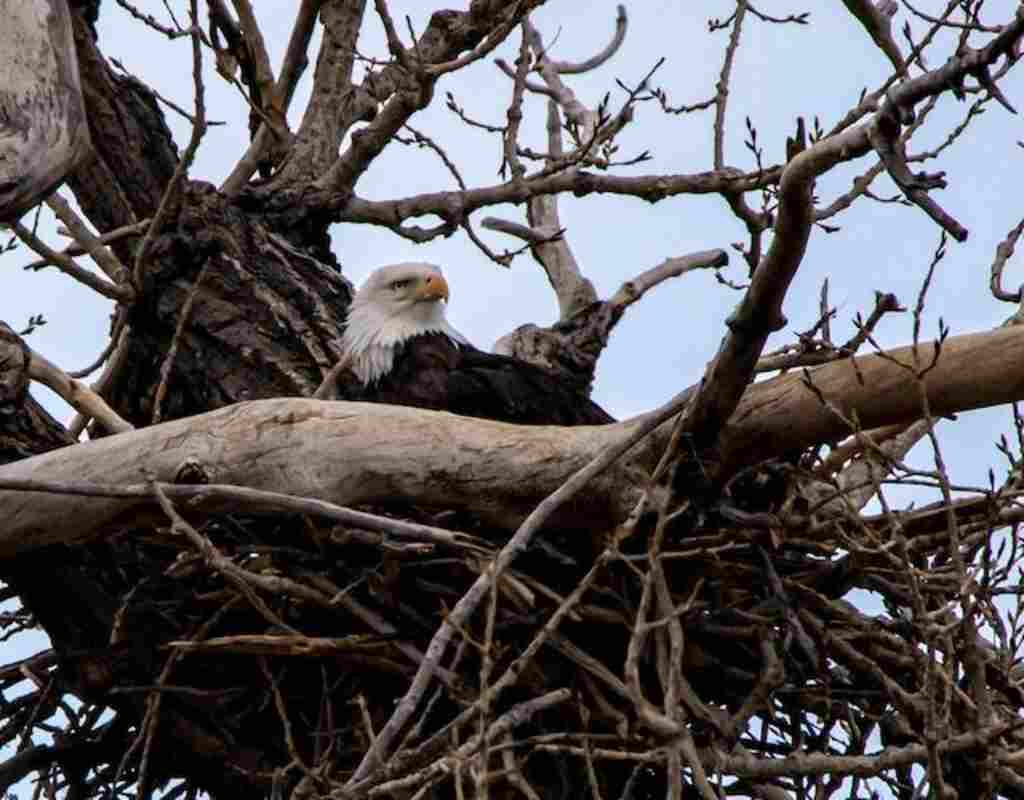
Nest Preparation and Egg Formation Process
A Nest Fit for an Eagle: Intricate Construction Techniques
Eagles are meticulous builders when it comes to their nests, known as eyries. These towering structures are typically built on high cliffs, tall trees, or even man-made platforms.
Constructing an eyrie requires careful consideration of size, materials, and location choices. Eagles prefer large nests that can reach several feet in diameter and depth.
Their construction involves interweaving thick branches and twigs along with softer materials such as grasses, moss, and feathers to create a cozy interior for the eggs.
The choice of materials is crucial in ensuring the stability and insulation of the nest.
Sturdy branches provide a solid foundation, while flexible twigs allow for expansion as the growing eaglets occupy more space.
The inner lining of finer materials serves to cushion the eggs during incubation while regulating temperature and humidity levels.
The Art of Maintenance: Importance for Successful Reproduction
Maintaining their nests is paramount for eagle pairs who aim for successful reproduction.
Both parents engage in regular maintenance activities that include reinforcing weak sections of the nest structure, adding additional bedding material, and removing debris or excess waste accumulations.
Nest maintenance plays a vital role in ensuring a favorable environment for egg-laying and incubation.
By regularly tending to their nests, eagles prevent potential collapses or disturbances that could jeopardize the fragile eggs or harm the growing eaglets once hatched.
Insight into Female Eagles’ Physiological Changes
A Complex Journey within: Maturation of Ovarian Follicles
Before female eagles can produce eggs, their reproductive organs undergo remarkable changes triggered by hormonal shifts within their bodies.
It all begins with maturation of ovarian follicles—tiny sacs containing immature eggs—within the female’s ovaries. Under the influence of hormones, selected ovarian follicles gradually grow, developing into ova (eggs).
This process can take several weeks or even months, depending on the species and individual factors such as age and health.
All the while, the female eagle’s body prepares for an imminent ovulation—the release of a mature egg from the ovary.
Ovulation: A Pristine Journey
Once an ovarian follicle reaches maturity, it ruptures and releases a fully developed egg into the female eagle’s oviduct. The oviduct is a specialized tubular structure where fertilization occurs if mating has taken place.
If fertilization is successful, the egg will continue its descent through the oviduct to be coated with protective layers before reaching the uterus, where it will develop further during incubation.
If fertilization does not occur, the unfertilized egg will still follow this journey, but will remain dormant until expelled from the female’s body.
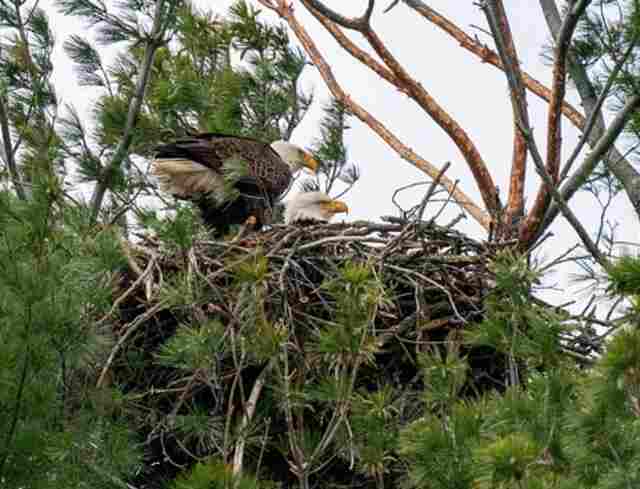
Conclusion
The nest preparation and egg formation process in eagles is a marvel of nature. From meticulously constructing sturdy nests to tending to them with care and precision, these majestic creatures demonstrate remarkable dedication to successful reproduction.
Additionally, understanding the intricate physiological changes that occur within female eagles provides us with insights into their reproductive journey.
By appreciating these processes, we gain a deeper respect for eagles’ resilience and their ability to adapt to various environmental conditions.
As we witness their tenacity in creating safe havens for their future generations, let us be inspired by their unwavering commitment to life itself.
May this knowledge encourage us to protect and conserve these magnificent birds so that they may continue gracing our skies for generations to come.
FAQs: When Do Eagles Lay Eggs?

